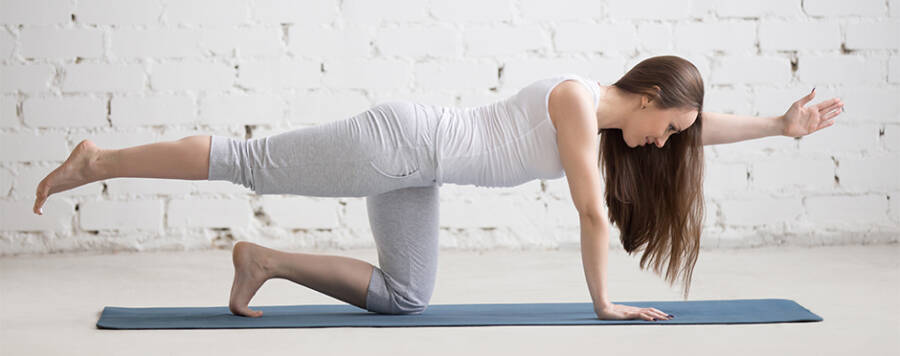Complete Core Workout
Muscle activation – multifidus, pelvic floor, T.A., and diaphragm
The multifidus, pelvic floor, transverse abdominus, and diaphragm are muscles that stabilize the spine and absorb force from the ground and gravity. Strengthening these muscles without compensating takes very accurate cueing and activation.
-
- Multifidus: lay on your back with one knee bent, GENTLY press your bent knee down into the floor/bed and hold for 5 seconds
- Transverse abdominus: lay on your back with your knees bent, use two fingers to find your pelvic bones in the front on both sides, and move your fingers in 1 inch and down 1 inch – this will be where you can feel the transverse abdominus activate. GENTLY draw your belly button in and up 1 cm – you will feel the muscle under your fingers press into your fingers or flatten out
- Pelvic floor: you can perform this in any position, GENTLY activate the muscles you would use if you were trying to stop the flow of urine and relax completely on the way out
- Diaphragm: this can also be performed in any position; place one hand on your chest and one hand on your belly, take a deep breath in and, fill your belly up with air (your chest should barely move), then release the breath
Cross slings – planks, chops, bird dogs, and dead bugs
The term cross slings are utilized when describing the functional components related to the core2. These muscles wrap across the body on the front and the back to provide functional stability with day-to-day activities.
-
- Planks: planks can be performed belly down, up, or on the side. This exercise will work on all aspects of the core. When performing a plank, no matter the direction, make sure to push up through the shoulder and keep the knees/toes in contact with the floor, squeeze your glutes, and keep your hips at shoulder height
- Chops: kneel on one knee. Utilizing a band, you will pull the band from a higher level to your hip or from your hip to the higher level
- Bird dogs: on your hands and knees, make sure your back is flat, reach out with your hand and opposite leg without moving your trunk, alternating sides
- Deadbugs: lying on your back with your knees over your hips and hands straight up in the arm, keeping your core engaged, reach out with your arm and opposite leg, alternating sides
Training your core not only helps to prevent running injuries but also helps to prevent injuries in day-to-day life. Seek a medical or health and fitness professionals, such as a personal trainer or physical therapist, for a specific core strengthening program customized to your needs. Seek professional advice from one of Athletico’s endurance team members if you are currently having pain with running or day-to-day activities.
Experiencing Aches or Pains? Come See Us!
Athletico is now offering free injury assessments via telehealth or in person. If you notice abnormal soreness, aches, or pains with your current training program, contact Athletico. Our team will assess your pain and provide recommendations for a treatment plan. Free Assessments are available in-clinic or virtually through our telehealth platform.
*Per federal guidelines, beneficiaries of plans such as Medicare, Medicaid, Tricare, VHA and other federally funded plans are not eligible for free assessments.
The Athletico blog is an educational resource written by Athletico employees. Athletico bloggers are licensed professionals who abide by the code of ethics outlined by their respective professional associations. The content published in this blog is for informational purposes only, does not constitute medical advice and should not be relied on for making personal health decisions.
References:
1. Elert, Glenn. “Force on a Runner’s Foot.” Force on a Runner’s Foot – The Physics Factbook, 1999, https://hypertextbook.com/facts/1999/SaraBirnbaum.shtml#:~:text=The%20Saucony%20shoe%20company%20reports,4700%20newtons%20(1000%20pounds).
2. Michael Lau PT, DPT. “Oblique Sling Exercise Progressions and Assessment.” [P]Rehab, 13 Oct. 2022, https://theprehabguys.com/oblique-sling-exercise-progressions/.
About the Author:
Paige Gibbens is a physical therapist specializing in lower extremity treatments and is certified in dry needling and Graston. She is also the Missouri & Southern Illinois regional coordinator for Athletico's Endurance Program.

 width="900"
height="356"
>
width="900"
height="356"
>
